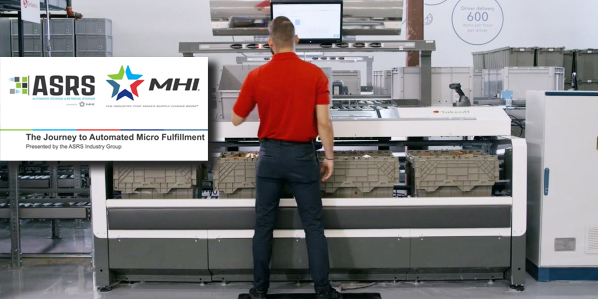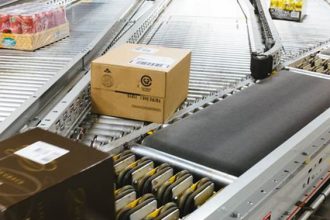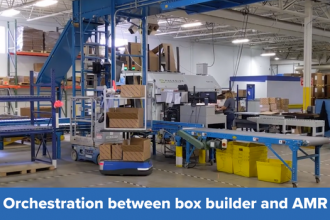Key Considerations When Developing An Automated Micro Fulfillment Strategy

More retail operations are exploring their options to add automated micro fulfillment technologies into their stores’ backrooms as a result of the COVID-19 pandemic. These solutions help mitigate the challenges retailers experienced with limited inventory, store-based pickers crowding aisles, restricted floor space, and heightened turnaround time pressures that became so pronounced in the spring of 2020.
This topic was recently explored in a webinar presented by the Automated Storage and Retrieval Systems Industry Group of MHI, wherein a panel of speakers discussed “The Journey to Automated Micro Fulfillment.” The solution incorporates a high-density automated storage and retrieval system (ASRS) deployed within the footprint of a brick-and-mortar facility that holds totes containing the most frequently picked items. This, the first of a two-part post, offers insights into the key considerations a retailer must take into account when developing an automated micro fulfillment strategy for their in-store operations.
First, a quick look at the challenges such retailers currently face. With shoppers worldwide embracing e-commerce at unprecedented rates due to the COVID-19 pandemic, traditional brick-and-mortar retailers are looking to learn from their spring 2020 experiences, when click-and-collect pick-ups and direct-to-consumer shipments vastly exceeded in-store shopping. To keep up with demand, many retailers staffed up. Yet customer service still suffered from stock-outs and extensive delays in receiving purchases.
In grocery particularly, many consumers who let someone else pick out their perishables for the first time in March and April 2020 — whether store employees or gig-economy shoppers working for Shopify and Instacart — have discovered they enjoy the convenience and will likely continue to use such services going forward. However, stores only have so much available inventory on-site, and limited space in their aisles for traditional customers, third-party shoppers, and employees pushing large, bulky carts through aisles (disrupting regular patrons) to fill online orders. Further, they have limited labor resources available at any given time to fill those orders and serve in-store customers.
The webinar explored how automated micro fulfillment solutions can address all these challenges by optimizing space, increasing throughput, reducing congestion in the aisles, and minimizing disruption to the customer experience. The first part of the 45-minute webinar included an extensive discussion of the key considerations that a retail operation should work through prior to undertaking such a project, and why they are important to the successful launch of the system. Three points were explored:
- Inherent Store Differences. No two stores have identical footprints, depending on the region in which they are located, the available space in an existing facility, the demographics of the surrounding areas, and the types and quantities of products they stock. Therefore, it is important for retailers to acknowledge that each automated micro fulfillment solution deployed will be different as well. Some can be retrofitted into existing facilities; other buildings will require a renovation to accommodate the new technology. Alternately, a greenfield project may be required, which requires a fresh analysis of that area’s shoppers and their expectations for inventory availability and order fulfillment.
- Software Integration. To successfully incorporate an automated micro fulfillment solution at the store level and maximize its potential, it is critical to align and unify all software to synthesize and streamline data inputs. Systems that should be integrated include e-commerce order portals, inventory management, vendor systems, point-of-sale, marketing and promotional strategies, track-and-trace food safety compliance, and items that require higher security. Doing so ensures a superior customer experience and increases loyalty. It also offers an opportunity to optimize store operations.
- Shifting Customer Expectations. As a direct result of the coronavirus pandemic, customers have come to expect click-and-collect (or click-and-deliver) availability from virtually every retailer, from mass market, to grocery, to home improvement. Due to universally increased demand for these services, customers have also shown that — for now — they are willing to accept next-day delivery. However, as the pandemic eventually begins to wane, customers will likely expect delivery of their orders within one or two hours. Additionally, COVID-19 changed shoppers’ habits, with baskets increasingly including chilled and frozen items as more people began cooking at home instead of dining out. Understanding consumers’ profiles both in terms of their expectations for order turn times and product types is a key component of creating an automated micro fulfillment solution that successfully meets a retailer location’s needs.
The retailer who considers all three of these key points when undertaking an automated micro fulfillment system design for their in-store fulfillment activities will be the one most likely to create an optimal customer experience and win repeat shoppers’ business.
The second part of this post reviews lessons learned from other retailers who have implemented these systems in terms of design, requests-for-proposal (RFPs), and installation. For more information about how an automated micro fulfillment system might benefit your retail operations, contact the members of the Automated Storage and Retrieval Systems Industry Group.



